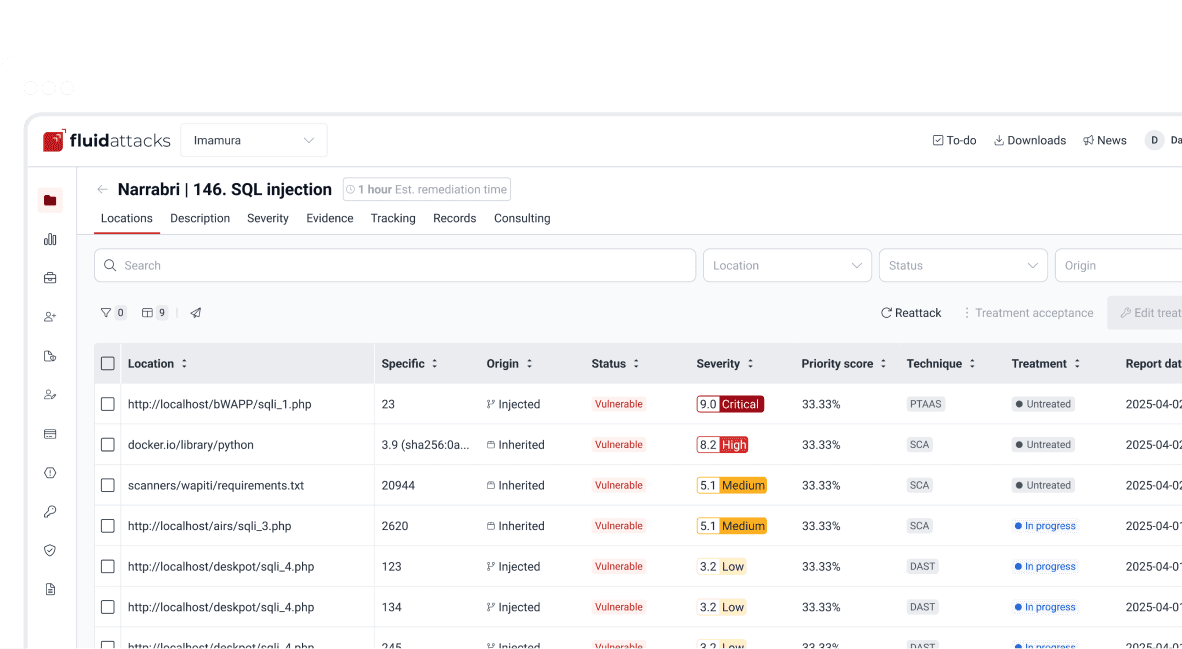Ataques
Exploiting the TRUN command of Vulnserver by using ROP

VP of Hacking
Actualizado
27 ago 2020
19 min
In the last blog posts, we’ve been dealing with DEP (Data Execution Protection) and a way to bypass it with ROP (Return-Oriented Programming). If you haven’t read those articles, I strongly recommend it before diving into this one.
In this article, we will use ROP to create a fully working exploit for the TRUN command of Vulnserver on a DEP-enabled Windows 10 OS.
ROP chains
In the last article, we used ROP to put the value 0xdeadbeef on EAX. To do that, we used 2 gadgets (sequence of instructions ending with RETN) that performed the needed operations. What we used is something known as a ROP chain, because we chained together pointers to gadgets on the stack. When one of the gadgets returns, will give control to the next, until the end of the chain.
ROP chains leverage existing instructions on the executable environment to perform arbitrary actions. In fact, it was demonstrated that ROP is Turing-complete, which means that we can solve any computational problem using it, which ranges from making EAX = 0xdeadbeef to creating a reverse TCP connection shellcode and beyond.
However, Turing-completeness does not imply code efficiency, and creating a working shellcode using ROP could be a very frustrating and tedious work.
Fortunately for us, we can reuse our old shellcodes. Yes, I mean it. But on a DEP-enabled OS, that involves a little of extra effort!
Marking shellcode as executable
When you use a CPU with the NX (No-execute) bit present, Windows provides DEP as a mean to leverage it. DEP is enabled by the OS which means that it can be disabled too.
That means that we can use ROP to disable DEP on certain memory region, place our good old shellcode there and redirect execution to that memory space.
There are many ways to do that, from creating a new heap into the process with execution permission to allocating new memory on the default heap with execution bit enabled or modifying existing memory to mark it as executable.
The most portable methods are the last two. The first (allocating new memory) is performed using the VirtualAllow() function. The second uses VirtualProtect().
What you may use depends on several things, mainly the version of Windows you are attacking. Also, if one of those functions is already loaded on the executable environment of the vulnerable application, it would be a good indicator.
Let’s load vulnserver.exe on a debugger to see if we can find one of those functions:

We were lucky. VirtualProtect() was found in the IAT (Import Address Table) of our executable. We will use that method.
VirtualProtect() signature
According to Microsoft, the VirtualProtect() signature is the following:
The parameters are:
lpAddressis the starting address on where we will store the shellcode.dwSizeis the size of the memory region we’ll mark as executable, starting atlpAddress.flNewProtectis the mask of bits defining the permissions that the address region would have (We’ll use this to mark it as executable).lpflOldProtectis an address that will receive the current permissions of thelpAddress + dwSizeregion.
Using ROP we need to put the values of those parameters on the stack. We also need to setup the stack in a way that we can return into the VirtualProtect() call and configure a return address that will be used as the next EIP when VirtualProtect() returns. The following diagram shows the expected stack layout just after executing our first RETN:
Stack layout.
Let’s see what would be the values of those parameters:
Address to
VirtualProtect(): This can be obtained using the debugger. Ideally, we will use later the reference on theIATto this function. For now, we found thatVirtualProtect()is at0x76070420:

Return address for
VirtualProtect(): This should be a pointer to aJMP ESPorCALL ESPinstruction. This will redirect the execution flow to our shellcode when theROPchain finishes, enabling the execution flag on the stack. You can obtain multiple options for this value using!mona jmp -n -r esp. I will pick0x625011AF.

lpAddress: This should be the start address on where we expect to store our shellcode. In our case, this should be the value ofESPand the value can only be obtained at runtime. We’ll get to that later.dwSize: Is the size of the address region that will be marked as executable, starting atlpAddress. Something like512bytes (0x200) would be enough.flNewProtect: Flags to be setup on the memory region. We need to mark it as executable, readable and writable (PAGE_EXECUTE_READWRITE) whose value is0x40lpflOldProtect: A pointer to a memory region that will receive the current permissions oflpAddress. That means that this value should point to a place where we have write permissions. You can use the debugger to find the right place. Ideally, this should be an address to a module withoutASRLorRebase. In this case, I’ll choose the one at0x62504040:

Verifying execution
Before ROP’ing those values, let’s check if that call works. I will update the exploit from the previous article with the call to VirtualProtect(). The goal of that exploit was to make EAX = 0xdeadbeef. I will use placeholder values where needed, and update them at debug time, just to check how VirtualProtect() works:
I will now run the exploit in stages, to explain every step:

Here, we can see that we effectively injected the parameters on the stack and that our first RETN gave control to call VirtualProtect(). However, there are some values that need to be changed. Let’s do that:

In this part, I modified the lpAddress value with the current value of ESP, then modified dwSize making it 0x00000200 or 512 bytes, and flNewProtect was set to 0x40 (PAGE_EXECUTE_READWRITE). Now, let the exploit continue with the modified values:

Wonderful! The VirtualProtect() call effectively marked the region where our shellcode was placed as executable and we could make EAX = 0xdeadbeef. We bypassed DEP again!
However, that was not a valid execution because we had to use the debugger to change some values.
ROP it all
We need to use ROP to setup those values. The easiest way is to put the required values on general purpose registers and then push them to the stack in the required order. To do that, we can harness the PUSHAD instruction that will save all the general purpose registers on the stack in the following order:
EAX,ECX,EDX,EBX,ESP,EBP,ESI,EDI.
That means that when PUSHAD is executed, the stack will have this content:
Stack layout.
The most important value for us is the original ESP value because that address is the one that must placed on the lpAddress parameter. Using lpAddress as the starting point, we need to place the other parameters to the adjacent registers, as well as the pointer to VirtualProtect() and the return address:
Stack layout.
Great, all the parameters for VirtualProtect() fit on those registers.
But something happens here. You may notice that the EDI register is not used, but when our first RETN is executed, it will land there. In that case, we need to store on EDI a pointer to a RETN instruction again. This will make the execution return to where ESI address is pointing, which is the call to VirtualProtect():
Stack layout.
You will also note that EAX is also not set and this is the place where the shellcode is supposed to start. To overcome that, we can fill EAX with NOP instructions that will slide the execution to the shellcode:
Stack layout.
Perfect. We need to use ROP gadgets to setup those registers first and then add a pointer to a PUSHAD # RETN gadget at the end of the chain. Fortunately for us, mona will do the hard work, by issuing the following command:
This will go through all executable modules finding ROP gadgets that can be useful. At the end, mona will generate several files with the result. The most important one in this stage is rop_chains.txt file that contains the chain of gadgets needed to setup the registers with the values in the required order.
This is the resulting ROP gadget chain in my system:
You can see that the registers are arranged exactly as we wanted.
We can incorporate that function in our exploit:
And check it:

Isn’t it wonderful? We were able to setup the call to VirtualProtect() with the required parameters using ROP.
Let’s resume the execution to check if that worked:

Indeed! Again, we were able to make EAX = 0xdeadbeef using a traditional shellcode. We can now replace that mock shellcode with one of our good ol' ones from msfvenom:
And update our exploit:
Note that I added the and esp, 0xfffffff0 instruction before the shellcode to align the stack. This is commonly needed when you mess around with the stack.
Let’s check it now:

Great! We successfully disabled DEP for our process and got a shell!
You can download the final exploit here.
Conclusions
In this article, we used the power of Return-Oriented Programming to complete a working exploit with a binded TCP shell on a DEP-enabled OS. As each application is different, using ROP gadgets to perform complex operations is an art, because there is not a generic way to do it.
Get started with Fluid Attacks' PTaaS right now
Suscríbete a nuestro boletín
Mantente al día sobre nuestros próximos eventos y los últimos blog posts, advisories y otros recursos interesantes.
Otros posts














